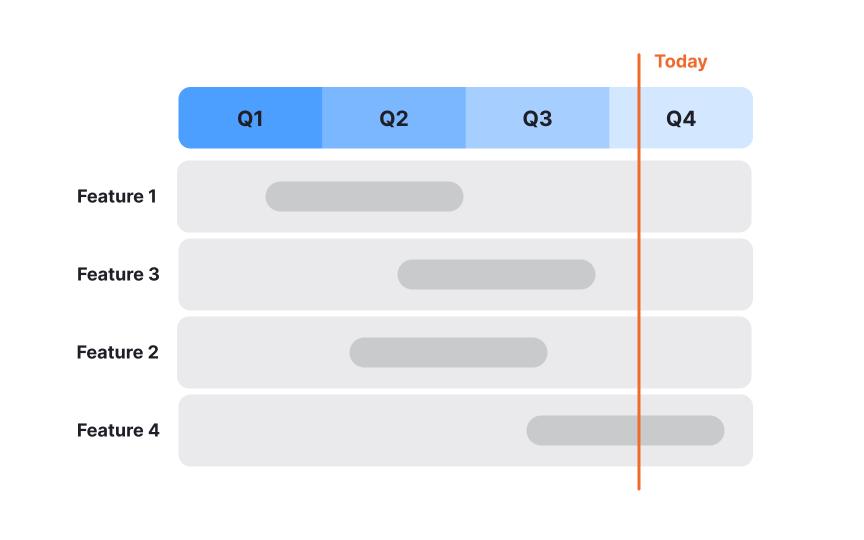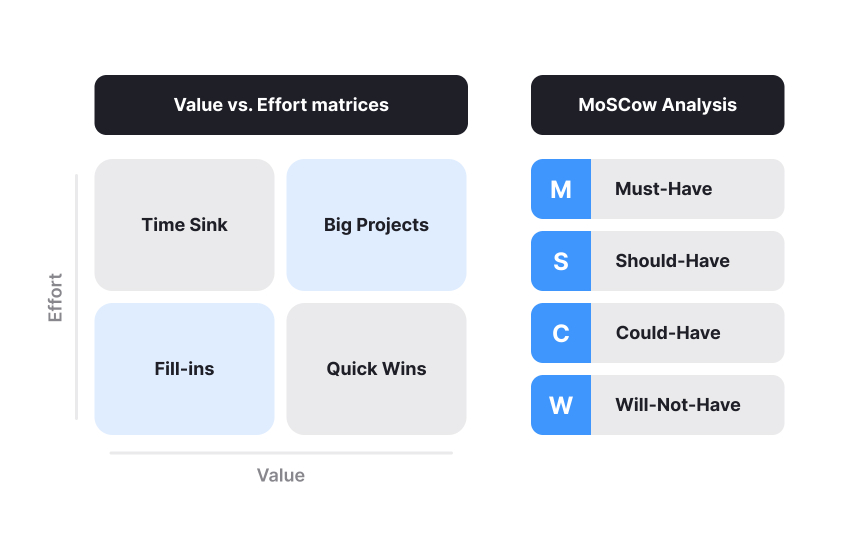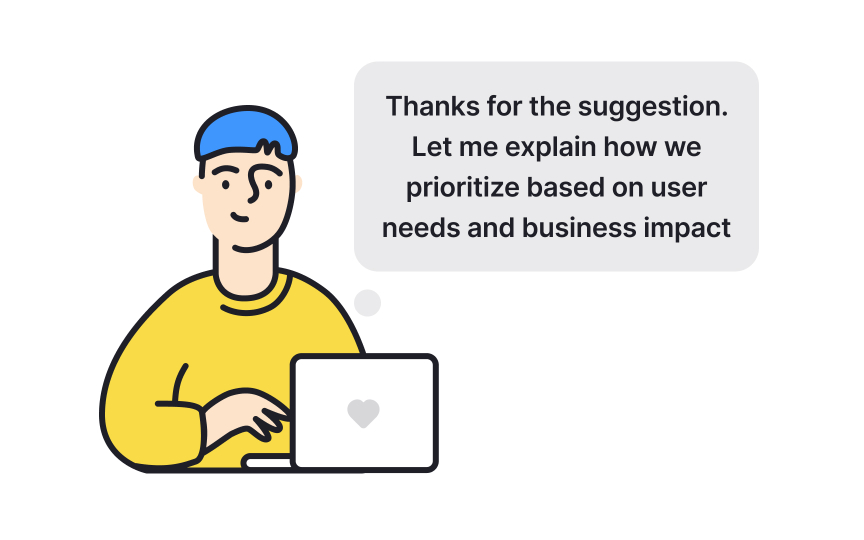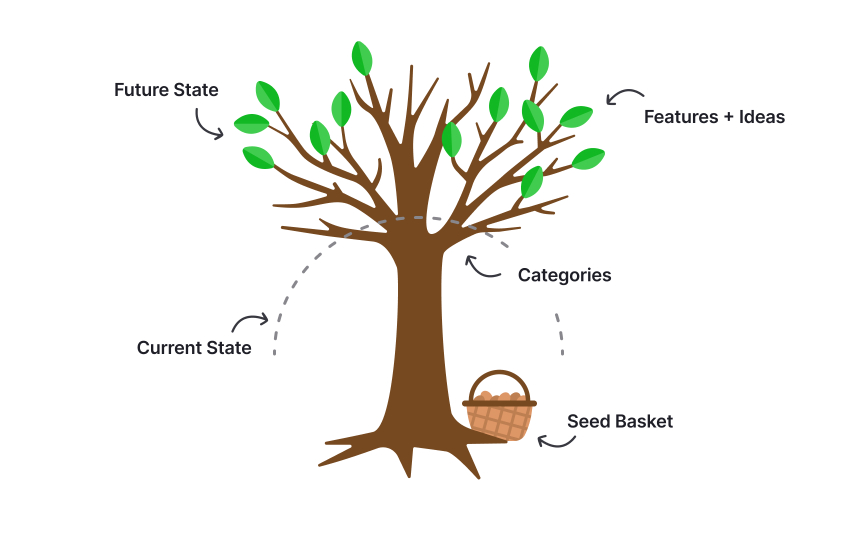Roadmaps and Prioritization
Master essential roadmapping techniques and prioritization frameworks to make strategic product decisions.
Product roadmaps bridge the gap between big ideas and actually building them. They show the path forward for product development, helping teams stay focused on shared goals. Good roadmaps explain the "why" behind each decision, not just listing features. They tell a story that connects what the business needs with what users want.
Prioritization frameworks are the practical tools that help decide what to build first. Whether using RICE scoring with its data-driven approach or the straightforward MoSCoW method that sorts features into must-haves and nice-to-haves, these frameworks help make tough choices about where to spend limited resources.
When product managers master roadmapping and prioritization together, they can handle competing demands, focus on work that truly matters, and build products people actually want to use. In competitive markets, these skills often make the difference between products that succeed and those that don't find their audience.
Product roadmaps help teams work together by showing everyone the plan for the product's future. A good roadmap explains both what you're planning to build and why it matters. It's a tool that turns your big-picture strategy into specific plans teams can follow. Effective roadmaps do several important things: they describe your product vision, guide teams during execution, get stakeholders on the same page, help with planning discussions, and communicate your direction to customers and partners. Modern roadmaps focus on strategic themes rather than just listing features with deadlines. This approach gives teams more flexibility while still providing clear direction. Each item on your roadmap should connect to specific business goals or customer needs. Some teams use timeline-based roadmaps with rough timeframes, while others group items by themes without specific dates. Either way, keep your roadmap flexible enough to adapt as you learn more about your market and customers.
Pro Tip: Keep your roadmap high-level. Too many details can lead to micromanagement and make it harder to adapt when needed.
Different audiences need different information from your roadmap. Creating specialized versions helps communicate effectively with each group:
- For executives, focus on high-level strategic concepts like driving growth, market position, or customer satisfaction. These roadmaps should connect product initiatives to business goals and show expected ROI rather than technical details.
- Engineering roadmaps often focus on features, releases, sprints, and milestones. They're typically more granular and include as much detail as possible about implementation to help developers understand what they'll be building and when.
- Sales teams need roadmaps that show how the product will help them sell more. Focus on customer benefits, group features into themes for easy discussion with prospects, and avoid specific dates to prevent premature commitments. Instead, provide approximate timelines for upcoming launches and highlight the benefits these will bring to customers.
- For customers, create simple, visually appealing roadmaps that emphasize benefits to them. These external roadmaps should be easy to understand and typically avoid specific release dates to maintain flexibility. Consider publishing these product updates on your company’s blog or appropriate social channels as a way of sharing with your customers what’s coming up.[1]
Pro Tip: Use a dedicated roadmapping tool that lets you create different views for various audiences without duplicating work.
Product roadmaps change significantly as products move through different lifecycle stages.
- Early-stage products. The roadmaps typically have shorter time horizons with frequent updates. These roadmaps focus on proving product viability, acquiring initial users, and establishing market fit. The horizon for startup roadmaps is usually shorter because predicting future requirements is difficult when you're still learning about your customers. Early-stage products often need to "always be shipping" with rapid release cycles to quickly validate assumptions.
- Established products. As products mature, roadmaps can extend further into the future with more confidence. Established products have a better understanding of their customers and market, allowing for more reliable long-term planning. Release cycles often become more structured and less frequent.
- Mature products also face more complex dependencies. While startups can "move fast and break things," established products must consider legacy systems, third-party integrations, and potential regression issues. Their strategic goals shift from rapid growth and market validation to maintaining position, expanding to new segments, and improving operational efficiency.
Pro Tip: Adapt your roadmap's time horizon, detail level, and update frequency based on your product's maturity stage.
Creating an effective roadmap starts with understanding your product strategy and business objectives. Follow these key steps:
- Identify your
product vision and the problems you're solving for customers - Establish clear, measurable goals that your roadmap will help achieve
- Focus on strategic themes rather than individual features
- Define success metrics for each theme to measure progress
- Gather input from key stakeholders while maintaining control
- Determine an appropriate time horizon based on product maturity
Themes group related
Pro Tip: When determining your roadmap's structure, consider whether to organize by time-based releases or by priority without specific dates. For newer products or volatile markets, shorter horizons provide more flexibility.
- RICE scoring model evaluates features based on Reach (users impacted), Impact (effect on those users), Confidence (certainty about estimates), and Effort (resources required). This quantitative approach creates a single prioritization score to help rank
initiatives . - MoSCoW method categorizes features into Must-haves, Should-haves, Could-haves, and Won't-haves, creating a clear hierarchy that's easy to communicate to stakeholders.
- Value vs. Effort matrices plot initiatives based on their potential value against implementation effort, helping teams identify "quick wins" (high value, low effort) and avoid "money pits" (low value, high effort).
- Kano model focuses on customer satisfaction, categorizing features as basic needs (expected), performance features (more investment equals higher satisfaction), or delighters (unexpected features creating high satisfaction).
Each framework has strengths for different situations. Many product teams combine approaches or adapt frameworks to fit their specific context and decision-making style.[2]
Successful
- Define what "value" means for your specific product context
- Create a clear scoring guide that everyone understands
- Document your prioritization decisions and their rationale
- Review and adjust your approach as your product evolves
Start by establishing what value means for your product. Is it revenue impact, user engagement, retention, or another metric? Then create a scoring guide that clearly describes what each level of your criteria means. For example, specify what "high effort" versus "medium effort" looks like in terms of development time or complexity.
Remember that prioritization isn't a one-time activity. Review your approach regularly and be willing to adapt your framework if it's not producing the desired outcomes or if business priorities shift.
Product roadmaps are powerful tools for alignment across departments. Effective collaboration with different teams improves both the quality of your roadmap and its successful implementation:
- Work with engineering early to understand technical feasibility and potential challenges
- Engage marketing and sales to gain insights on market trends and the competitive landscape
- Include customer success and support to tap into direct user feedback and pain points
- Tailor roadmap discussions to emphasize what matters most to each group
When collaborating cross-functionally, create a shared vocabulary around your roadmap to avoid misunderstandings. Clearly define terms like "committed," "exploring," or "considering" to set appropriate expectations about the certainty of different
Pro Tip: As a PM, you’re not expected to be able to identify technical constraints yourself. That’s why it’s essential you build a strong relationship with your engineers, so that you can empower them to give the technical input you need.
Managing stakeholder expectations is perhaps the most challenging aspect of product roadmapping. Creating alignment requires both strategy and diplomacy:
- Map your key stakeholders and understand their specific priorities and concerns
- Be clear about how you make
prioritization decisions - Learn to say "no" politely by acknowledging suggestions while explaining priorities
- Actively communicate roadmap changes and progress
When plans change, as they will, explain "why" rather than waiting for stakeholders to discover changes on their own. This builds trust and keeps stakeholders confident in the roadmap process. A common challenge is having to change your plans due to management requests without clear reasoning. This often happens when the company strategy and product strategy aren't aligned. Product leaders need to bridge this gap by improving communication in both directions.
Sometimes, the reverse might happen: a feature that initially seems low-value may have a business need behind it that you’re not aware of. Discussing the rationale for the suggestion with your stakeholders will help spot when this is the case.
The Product Tree framework offers a visual, collaborative approach to roadmap planning. This method uses the metaphor of a tree to represent your product's growth and priorities:
- Trunk: Represents your core product functionality
- Branches: Different product areas or capabilities
- Leaves: Specific features or enhancements
To run this exercise, gather representatives from different departments: product, engineering, design, sales, and customer success. Draw a large tree outline on a whiteboard or use a digital collaboration tool. Provide participants with sticky notes to write potential features or improvements.
Ask everyone to place their feature "leaves" on the branches where they believe they belong. This creates a visual representation of how your product might evolve. Features placed closer to the trunk typically represent near-term priorities, while those further out might be longer-term opportunities.
Once complete, facilitate a discussion about the balance across the tree. Are some branches overloaded while others are empty? This might indicate areas receiving too much or too little attention. Does the distribution align with your strategic priorities?[4]
Pro Tip: Take photos of your product tree after each session to track how your priorities evolve over time.
How you share your roadmap matters as much as what's in it. A good presentation builds support and excitement for your product direction:
- Tell a story about your strategy instead of just listing features
- Adjust your presentation for different audiences
- Keep discussions high-level, focusing on themes and outcomes
- Include ways to measure success for each part of the plan
Before presenting, learn what matters to your audience. Share the roadmap with key decision-makers early to address concerns before the main presentation.
Throughout your presentation, tell a compelling story about how your roadmap connects to user needs and business goals. This helps everyone understand why you've made certain decisions and builds stronger support.
Pro Tip: Practice your roadmap presentation with a colleague before sharing with larger groups to find gaps in your story.
References
- The Ultimate Guide to Product Roadmaps | ProductPlan
- Product Prioritization Frameworks: The 9 Most Popular | Product Management Resources | Roadmunk
Top contributors
Topics
From Course
Share
Similar lessons

Why You Need a Roadmap

Planning Roadmaps and Backlogs























